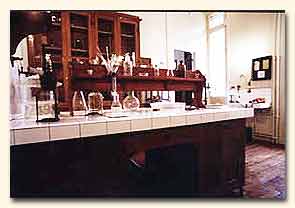|
Alongside the research,
the Radium Institute became an international center for measuring
the radium content of various products. Curie believed that providing
this service, necessary for doctors and others who used radium,
was a personal responsibility.
 |
 |
| The Curie Museum in Paris keeps
Marie Curie's office in the Radium Institute as she left it,
as well as the chemical laboratory that she and Irène
Joliot-Curie used. The laboratory (right) was reconstructed
in 1981--and decontaminated, for it was too radioactive for
safe occupancy. (© Rachel Paty-Musée Curie) |
 HE
CENTRAL TASK of her life was no longer her own research, but
directing the Curie Institute. Seeing that science was becoming
specialized, she organized the Radium Institute in a new way--an
entire major laboratory devoted to a single subject. Researchers
formed small teams, each team with its own independent questions
but always about radioactivity. Each team not only attacked its
questions but also served as a training-ground for students. The
institute housed three or four dozen researchers, and Curie kept
in touch with the details of the work of every one of them. From
the moment she arrived in the morning she would be surrounded by
researchers. Often she stopped to sit with them on the stairs of
the narrow entrance hall, briskly discussing the problems of the
day. HE
CENTRAL TASK of her life was no longer her own research, but
directing the Curie Institute. Seeing that science was becoming
specialized, she organized the Radium Institute in a new way--an
entire major laboratory devoted to a single subject. Researchers
formed small teams, each team with its own independent questions
but always about radioactivity. Each team not only attacked its
questions but also served as a training-ground for students. The
institute housed three or four dozen researchers, and Curie kept
in touch with the details of the work of every one of them. From
the moment she arrived in the morning she would be surrounded by
researchers. Often she stopped to sit with them on the stairs of
the narrow entrance hall, briskly discussing the problems of the
day.
|
|
Curie's research
staff always included some foreigners, especially Poles and some
women. She considered all the researchers working under her direction
her “children.” One of them, Salomon Rosenblum, made a
major discovery in 1929, when his work with actinium (prepared by
Curie herself) helped confirm quantum theory. But her own daughter
Irène and son-in-law Frédéric Joliot became the stars of the
Radium Institute. Curie did not live to see the Joliot-Curies receive
a joint Nobel Prize for Chemistry in December 1935. But she did
witness in early 1934 their triumphant discovery of artificial radioactivity,
for which the prize would be awarded. Meanwhile Eve too achieved
distinction--not in science but for her writing (including a popular
biography of her mother).
“It
was certainly a satisfaction for our late lamented teacher, Marie
Curie, to have seen the list of radioactive elements that she
had the honor to inaugurate with Pierre Curie so extended.”--Frédéric Joliot-Curie, in his Nobel Prize lecture
|
 |
| Receiving the 1935 Nobel
Prize. Unlike Marie Curie's experience when sharing her first
Nobel Prize with Pierre, Irène and Frédéric Joliot-Curie each
delivered part of the Nobel lecture explaining the significance
of their work. (Photo ACJC) |
|
|
As all-consuming
as her involvement with the Radium Institute was, Curie also
found time in the last 12 years of her life to serve on the
commission on Intellectual Cooperation of the League of Nations.
In this capacity she worked toward establishing an international
bibliography of scientific papers, developing standards
for international scientific scholarships, and protecting
researchers' ownership of intellectual rights for their discoveries.
|
 |
| When Curie learned that Einstein, like
her, had been appointed to the League's Commission on
Intellectual Cooperation, she sent a letter urging him
to serve: “I believe your acceptance, as well as
mine, is necessary if we have any hope of rendering any
real service.” |
|
|
� 2000 -
American Institute of Physics |

